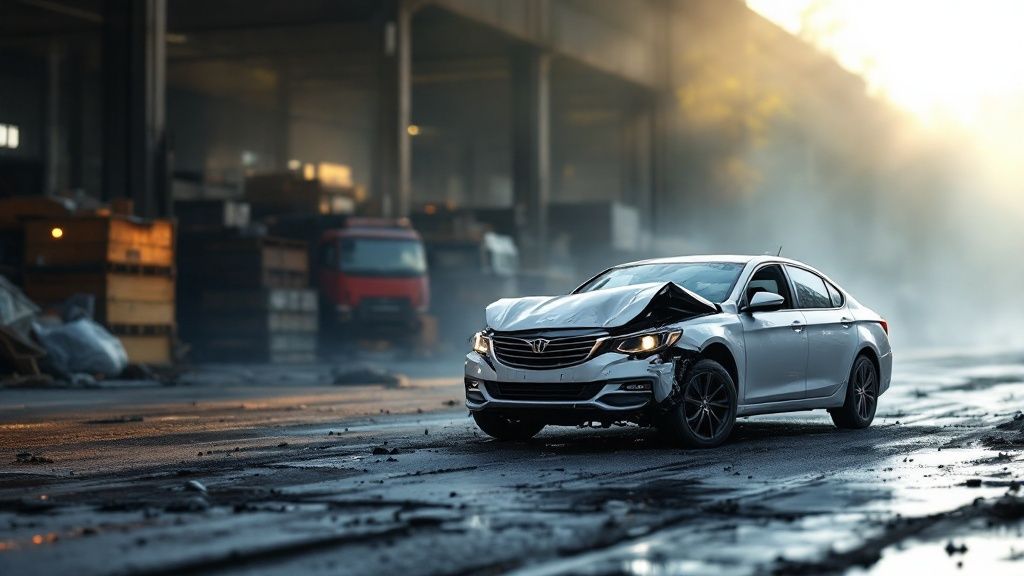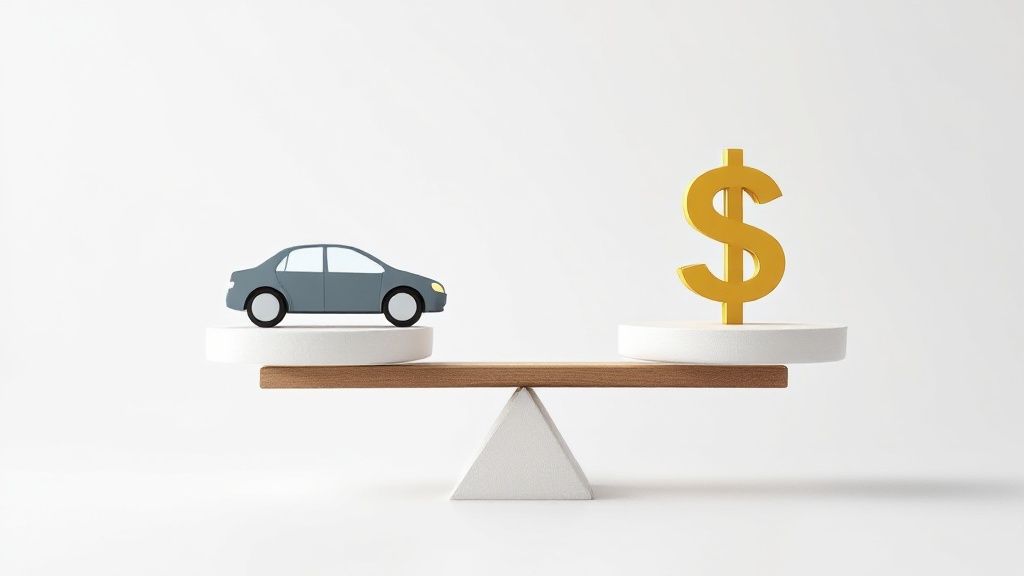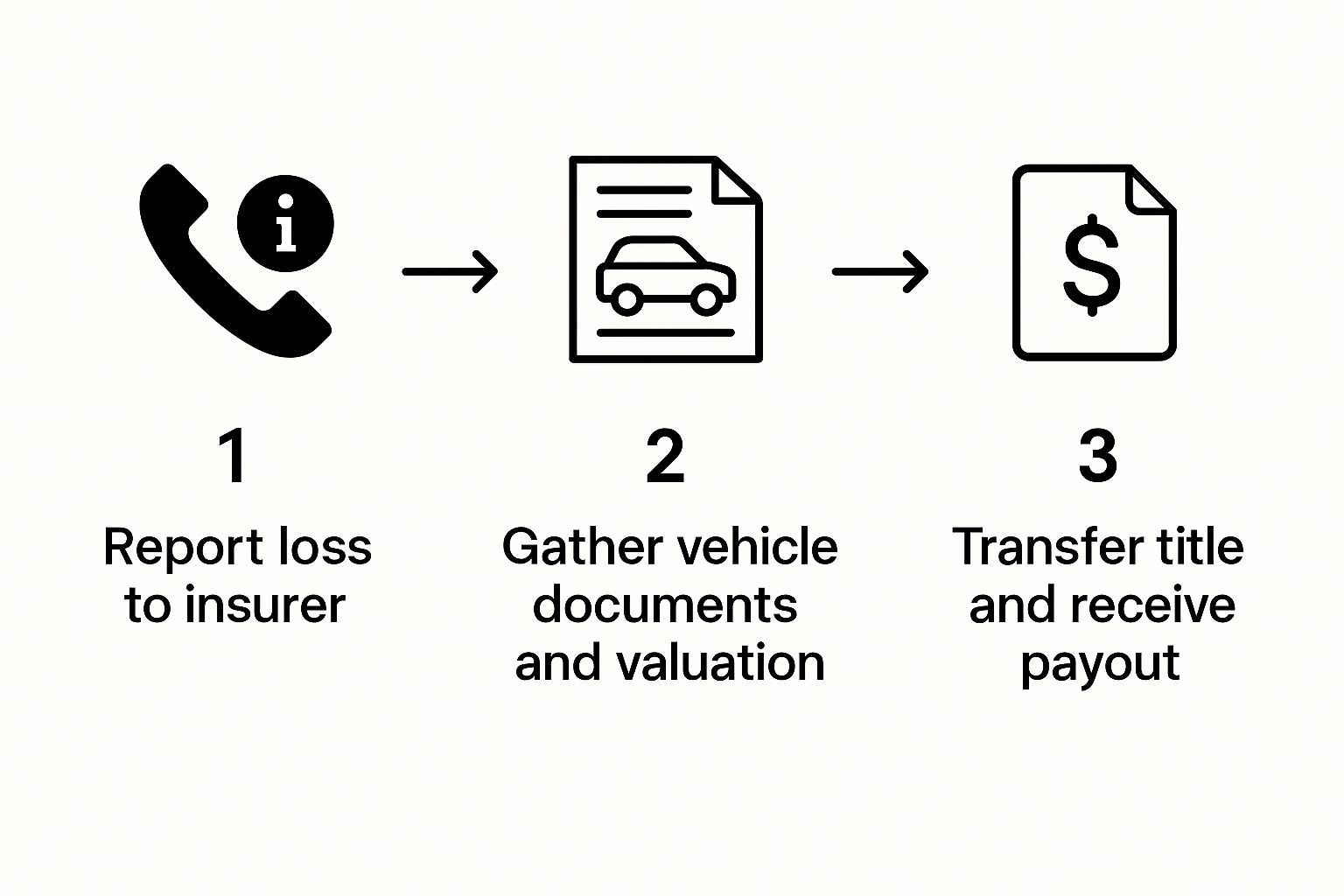The totaled vehicle value isn't what you paid for your car or what you still owe on it. It’s the amount your insurance company figures your car was worth in the moments right before the accident happened.
This number, officially called the Actual Cash Value (ACV), is the bedrock of the settlement offer you'll receive if your car is declared a total loss.
What Does Totaled Vehicle Value Really Mean

When an insurance adjuster tells you your car is a "total loss," they’re not making a judgment on the car itself. It’s a purely financial decision. They've run the numbers and concluded it would cost more to fix your vehicle than to simply pay you what it was worth.
Think of it this way: it’s like a home appraisal after a major storm. The focus isn't on the original price tag or your memories, but on its cold, hard market value just before the damage occurred. Understanding how they get to that number is the key to making sure you get a fair shake.
The Building Blocks of a Total Loss Decision
The insurer's process isn't just guesswork; it's a specific formula. Getting a handle on these moving parts helps you see exactly how they arrived at their offer. Let’s break down the essential elements they use to determine whether you get a check for repairs or a check for your car's total value.
The Core Components of a Total Loss Calculation
| Component | What It Is | Its Role in Your Settlement |
|---|---|---|
| Actual Cash Value (ACV) | The market value of your vehicle—factoring in its make, model, age, mileage, options, and condition—right before the accident. | This is the most important number. It forms the foundation of what the insurance company will offer you for your totaled vehicle. |
| Repair Estimate | The total projected cost to bring the vehicle back to its pre-accident state, including all parts and professional labor. | If this cost gets too close to the ACV, the insurance company will lean heavily toward declaring it a total loss. It's a key tipping point. |
| Salvage Value | The amount a salvage or scrap yard would pay for your wrecked vehicle for its remaining usable parts and scrap metal. | This amount is subtracted from the ACV. Insurers see this as a way to recoup some of their costs by selling the wreck. |
At the end of the day, the insurance company is doing simple math. They compare the cost of repairs to the car's ACV minus what they can get for it at a salvage yard.
The total loss formula is straightforward: If the Repair Estimate is greater than the (Actual Cash Value – Salvage Value), your car will be declared a total loss.
The most critical—and often most debated—part of this equation is the ACV. You can get a much deeper understanding by reading our guide on what the Actual Cash Value of your car really is.
Understanding the Language of a Total Loss Claim

If you want to navigate your claim successfully, you first have to learn to speak the insurer's language. Their entire process hinges on a few key terms that directly control the totaled vehicle value you're offered. Getting a grip on these concepts is the first, most important step toward a fair settlement.
The term you'll hear most is Actual Cash Value (ACV). This isn't the price you paid for the car, and it's not what a dealer is asking for a similar one on their lot. ACV is the real-world, fair market value of your specific car—with its exact mileage, condition, and options—in your local area, just moments before the crash.
Think of it this way: if you had sold your car privately on the day of the accident, ACV is the realistic price you would have gotten for it.
Decoding the Core Terminology
Insurance adjusters don't just pull these numbers out of thin air. They rely on specific definitions and data points to build their valuation. Once you understand these terms, their offer sheet becomes much less intimidating, giving you the confidence to negotiate.
Let's break down the three pillars of any total loss calculation.
- Actual Cash Value (ACV): As we covered, this is your car's pre-accident market worth. Insurers get this number from third-party companies that analyze recent sales of comparable vehicles in your region.
- Total Loss Threshold: This is a percentage set by state law or your policy. If the estimated repair cost climbs past this percentage of your car's ACV (often around 75%), the vehicle is automatically "totaled."
- Salvage Value: This is what a scrap or salvage yard will pay for your wrecked car. The insurance company sees this as a rebate; after they pay you, they sell the wreck to get some of that money back.
The final decision is a constant balancing act between these three figures. The insurer is always weighing the cost to repair your car against the cost of paying you its ACV and then selling the salvaged remains.
How Depreciation Shapes Your Final Offer
Depreciation is the silent, ongoing force that chips away at your car's value. It starts the second you drive it off the lot and continues with every mile you add. It’s just a fact of car ownership.
Where it gets tricky, however, is how the insurer calculates that depreciation. This can have a massive impact on your ACV.
An insurer's valuation report will list "adjustments" for mileage, prior damage, and overall condition. These adjustments are just applied depreciation, and they directly lower the final totaled vehicle value you are offered.
A car with high mileage, for example, will get a negative dollar adjustment. A pristine, low-mileage example might get a positive one. This is often where disputes begin, so you need to make sure the insurer’s assessment of your car's pre-accident condition is spot-on.
The Real-World Impact of Market Conditions
The car market is never static; it ebbs and flows with the broader economy, and that has a direct effect on your settlement. For instance, average adjusted vehicle values fell by about -6% in 2024, yet they remain roughly 39% higher than they were back in 2020 because of supply chain issues and production costs. You can dig into more of these market trends in recent industry crash course reports.
This volatility means a car's ACV today could be thousands of dollars different from what it was a year ago.
Several key factors drive these market-wide shifts:
- New and Used Car Inventory: When fewer new cars are being made, demand for used cars skyrockets, pushing their prices—and ACV—up.
- Repair Costs and Complexity: Modern cars, with all their sensors and tech, are incredibly expensive to fix. With complex calibration procedures now showing up in over 31% of repair estimates, it’s easier than ever for a car to hit its total loss threshold.
- Scrap Metal and Parts Prices: High prices for scrap metal or valuable used parts can increase your car's salvage value, which also influences the insurer's final calculation.
These outside forces are always shaping the landscape where your totaled vehicle value is determined. Knowing they exist gives you a much clearer picture of the insurer's offer—and a stronger footing to negotiate a better deal.
Market Forces That Shape Your Vehicle's Value

The value of your totaled car isn't determined in a vacuum. It’s deeply tied to the ever-shifting automotive market. Think of it like a stock price—it’s not just about the company's performance, but also about industry news, economic forecasts, and overall consumer confidence.
In the same way, your vehicle's worth is constantly nudged up or down by powerful market forces. These ripples directly influence both its Actual Cash Value (ACV) and its salvage value, which together shape the final settlement offer you see from the insurance company.
Understanding these hidden dynamics is the key to knowing why the insurer’s number is what it is. Sometimes they work for you, and sometimes against you.
Supply and Demand for New and Used Cars
The biggest driver here is classic supply and demand. When new cars are scarce because of factory slowdowns or supply chain nightmares, more people turn to the used car market. That surge in demand naturally drives up the prices for used vehicles across the board.
This directly helps your totaled vehicle value. If used car prices are hot, the "comparable" vehicles the insurer uses in their valuation report will also be more expensive. That means your car's ACV gets a boost, leading to a better settlement.
On the flip side, when dealership lots are overflowing with new models and juicy incentives, used car prices tend to cool off. In that kind of market, the ACV for your vehicle might come in lower than you'd hope.
Your car’s value is a snapshot in time. A vehicle totaled during a period of high used car demand is inherently worth more than the exact same vehicle totaled during a market downturn.
This ebb and flow is always happening. For instance, projections for global new vehicle sales were set to hit 89.6 million units in 2025, and that kind of steady growth keeps the used market humming. This consistent demand props up used car prices and, by extension, leads to better settlements.
The Ripple Effect of Parts and Labor Costs
It’s not just about whole cars; the market for individual parts and the cost of labor also play a massive role. Tariffs on imported auto parts, a shortage of microchips, or rising wages at body shops can make repairs way more expensive than they used to be.
At first glance, this might not seem connected to your car's value. But think about it: as repair costs climb, it becomes much easier for a vehicle to hit its total loss threshold. A fender-bender that was a simple repair a few years ago might now push the car into "totaled" territory.
This has a secondary effect on the salvage value, too.
- High-Demand Parts: If your car model has parts that are hard to find or in high demand (like a specific engine or transmission), salvage yards will pay top dollar for the wreck.
- Increased Salvage Bids: This higher salvage value makes it even more appealing for the insurer to total the car, since they can get a bigger chunk of their payout back from the sale.
Even something as remote as a trade policy can directly influence whether your car gets fixed or you get a check for its totaled vehicle value. For a deeper dive into how these factors contribute to the overall valuation, you can learn more about what determines a car's fair market value.
Broader Economic and Technological Shifts
Finally, big-picture trends in the economy and technology cast a long shadow over every vehicle's value. The auto industry is going through a massive transformation, and these shifts inevitably change the worth of the cars already on the road.
A perfect example is the move toward electric vehicles (EVs). As more people buy EVs, the demand for certain gas-powered models might start to drop, potentially lowering their ACV over time. Then again, a beloved, reliable gas model that’s no longer in production could become a classic, pushing its value up.
These larger movements create a complex and dynamic landscape for vehicle valuation. An appraiser has to consider not just your car, but the world it exists in, to arrive at a truly accurate number.
How Market Trends Impact Your Car's Valuation
The connection between broad market shifts and your insurance settlement can feel abstract. This table breaks down how specific economic factors can directly raise or lower your vehicle's valuation.
| Market Factor | Typical Change | Effect on Your Settlement |
|---|---|---|
| New Car Shortages | Reduced supply of new vehicles | Increases the value of used cars, likely raising your ACV. |
| High Gas Prices | Increased demand for fuel-efficient cars | Increases the value of hybrids/EVs; may decrease value for trucks/SUVs. |
| Rising Repair Costs | Higher parts and labor expenses | Makes it easier for a car to be totaled; can increase salvage value. |
| Low Interest Rates | Cheaper to finance a car purchase | Increases overall demand for cars, supporting higher used values. |
| Technological Shifts | Move toward EVs or new safety tech | Can decrease the value of older, less-equipped gasoline models over time. |
Ultimately, the goal of an appraisal is to determine what a willing buyer would have paid for your vehicle right before the accident. These market factors are what shape the decisions and prices of those very buyers.
How Insurers Calculate Your Settlement Offer
When your car is declared a total loss, the insurance company doesn't just pull a settlement number out of thin air. There’s a specific, data-driven process they follow to figure out exactly what your vehicle was worth moments before the crash.
The whole game revolves around one key term: Actual Cash Value (ACV). This isn't what you paid for the car, or what you think it was worth. ACV is what a similar car would have sold for in your local area right before the accident. To find that number, adjusters rely on sophisticated valuation software and real-world sales data.
Finding "Comps" to Set a Baseline
The first thing an adjuster does is search for "comparable vehicles," or "comps." Think of these as automotive twins to your car that have recently sold nearby. This isn't a quick search on Craigslist; they use specialized systems that pull from dealer and auction sales records to find the most accurate matches.
To qualify as a true "comp," another vehicle has to line up with yours on the most important details:
- Year, Make, and Model: This is the obvious starting point. A 2021 Honda Accord is only compared to other 2021 Honda Accords.
- Trim Level and Options: A base model is a world away from a fully-loaded touring edition with leather seats and a sunroof. The software gets this specific.
- Geographic Location: The same car can have a different value depending on where you live. A 4×4 truck in snowy Colorado is worth more than the same truck in sunny Florida, and the valuation has to reflect that local market.
Once the system identifies a handful of solid comps, the adjuster has a realistic starting price range for your vehicle. This list of comps is the foundation for the entire valuation report.
Adjusting for Mileage and Condition
Your car was unique, right? It had its own history, its own mileage, and its own little quirks. So, the insurer can’t just take the average price of the comps and call it a day. The next step is to make specific dollar adjustments—up or down—to account for the differences between your vehicle and the ones they found.
This is where the totaled vehicle value can really shift.
The two biggest factors are always mileage and condition. If your car had way fewer miles on the odometer than a comparable vehicle, they’ll add a positive dollar amount to the baseline value. If you had higher-than-average mileage, you’ll see a negative adjustment.
The same goes for its pre-accident condition. The adjuster will rate your car’s state (excellent, average, fair, etc.) and compare that to the comps. Any dings, dents, stained upholstery, or excessive wear and tear from before the accident will result in a negative adjustment, lowering the final offer.

As you can see, the process flows from one step to the next, but the most crucial part—and the one where you have the most input—is providing documentation to prove your vehicle’s true pre-accident value.
Finalizing the Actual Cash Value
After all the back-and-forth—adding for low mileage, subtracting for a scratch on the bumper, and factoring in your specific options package—the system crunches the numbers and spits out a final, adjusted figure. This is the insurer's official ACV for your vehicle.
The valuation report you receive should break down every single comp and every adjustment made. Carefully reviewing this document is the most important thing you can do to make sure the totaled vehicle value is fair and accurate.
It’s also worth remembering that the wider car market plays a huge role. For instance, recent data showed that used vehicle prices jumped 1.8% year-over-year. When the market for used cars is tight, the value of those "comps" goes up, which should be reflected in your settlement. You can learn more about how market trends affect vehicle pricing on Repairer Driven News.
Subtracting the Salvage Value to Get Your Offer
Once the ACV is locked in, there’s one last piece to the puzzle. The insurer will get a quote from a salvage yard for your wrecked car. This "salvage value" is what a company is willing to pay for the vehicle's remaining parts and scrap metal.
To arrive at their final offer, the insurance company simply subtracts this salvage value from the ACV they calculated. They pay you the difference and then sell the wreck to the salvage yard to recoup a small portion of their payout.
Strategies to Secure a Fair Vehicle Valuation
Getting the insurance company's first settlement offer for your totaled car can be a real gut punch. It often feels way too low, leaving you wondering what to do next. It’s easy to feel like you have no say in the matter, but you actually have more leverage than you realize.
Think of the insurer's valuation as just a starting point—their opening bid in a negotiation. It's based on their data and a quick assessment of your vehicle's condition. Your job is to build a strong counter-argument based on cold, hard facts to get the number where it ought to be.
Document Everything About Your Vehicle
Your best ammunition in this fight is solid documentation. The insurance adjuster working on your claim probably never saw your car before the crash. All they have are some wreck photos and a generic report that likely defaults to "average condition."
Your goal is to paint a crystal-clear picture of your car's true, pre-accident state. Dig up every piece of paper you can find.
- Maintenance Records: A stack of receipts for regular oil changes, tire rotations, and scheduled maintenance is proof that your car was well-cared for.
- Recent Upgrades: Did you just put on a brand-new set of tires? Or maybe you replaced the battery or installed a better stereo system right before the accident? Receipts for these items represent real, added value.
- Pre-Accident Photos: If you have any photos or videos showing off your car's pristine interior and gleaming paint job, they can directly challenge a lowball condition rating from the adjuster.
This kind of evidence builds a compelling case that your vehicle was in better-than-average shape, which should push its totaled vehicle value higher.
Find Your Own Comparable Vehicles
The insurance company used "comps"—comparable vehicles for sale—to come up with their offer, and you should do the exact same thing. This is where you get to find real-world evidence that supports the number you have in mind.
Search for vehicles that are a near-perfect match for yours: same year, make, model, trim, and similar mileage. Your best bet is to check local dealership websites, major online car marketplaces, and even local classifieds. Make sure you save screenshots or links for at least three to five solid examples that are listed for more than the comps the insurer used.
When you talk to the adjuster, stay cool and professional. You're not starting a fight; you're having a discussion. Try saying something like, "I appreciate you sending over the report. I did some research on the local market myself and found a few similar cars that seem to be valued a bit higher. Would you be open to looking at them with me?"
This approach shows you're serious and have done your homework, turning it into a collaborative process rather than a confrontation.
Know When to Call in a Professional
Sometimes, no matter how much proof you provide, the insurer just won't budge. If you’re still miles apart on the value and the dollar amount is significant, it might be time to use the "Appraisal Clause" in your auto policy.
This clause is your right to hire a certified, independent appraiser to conduct their own valuation. They will produce a highly detailed report based on objective market data and their own expert inspection, giving you a powerful tool to counter the insurer's position.
Yes, it costs money to hire an expert, but the difference they can make in your final settlement often far outweighs the fee. For anyone stuck in a negotiation stalemate, getting a professional total loss vehicle appraisal can be the move that finally gets you the fair payout you deserve.
Seeing Total Loss Claims in Action: Real-World Stories
It's one thing to talk about how total loss claims are supposed to work, but it’s a whole lot clearer when you see how it plays out for real people. The final totaled vehicle value an insurer offers is never just about a car's age and mileage. As you’ll see, small details can cause huge swings in the final settlement.
Let's walk through two very different scenarios. One involves a regular daily driver, and the other a unique classic. Each story shows how factors like maintenance, market quirks, and custom parts can completely change the outcome.
Case Study 1: The Well-Maintained Daily Commuter
Meet Sarah. She drove a seven-year-old sedan with 120,000 miles on the odometer. It was her trusty commuter car—not perfect, but she was diligent about its upkeep. After a nasty T-bone, her insurance company declared it a total loss. Their first offer? $8,500.
The insurer’s report seemed fair on the surface. It listed a few comparable cars with similar mileage that sold recently. The problem was, they slapped a "fair" condition rating on her car, docking its value for the high mileage and a few dings and scratches. Sarah knew her car was worth more, especially after the money she'd just put into it.
How Sarah Fought Back:
Instead of just rolling over, Sarah got organized. She dug up receipts for:
- A brand-new set of premium tires she’d bought just two months prior ($900 value).
- A major service that included a new timing belt and water pump—a big-ticket maintenance item ($1,200 value).
- A folder full of service records proving every oil change and tune-up was done on schedule.
She presented this stack of proof to the adjuster. Her argument was simple: her car wasn't just another "fair condition" vehicle. A buyer would absolutely pay more for a car with brand-new tires and a freshly serviced engine than for one needing that work done. The adjuster, faced with clear evidence, had to agree. They added a portion of those costs back into the valuation, and her final settlement jumped by $1,100.
The Big Lesson: Your service records are your best ammo in a negotiation. An adjuster will almost always overlook the value of recent maintenance or upgrades unless you hand them the receipts to prove it.
Case Study 2: The Restored Classic Truck
Now, let's look at Mark. He owned a beautifully restored 1985 pickup truck that was his pride and joy. When it was totaled in a garage fire, the insurance company's initial offer was a gut-punch: $7,000. Their valuation software saw a nearly 40-year-old truck and spat out a number based on standard, unrestored models.
That offer was a slap in the face. It completely ignored the thousands of dollars and countless weekends Mark had invested in the restoration. This is a classic trap for anyone with a unique, classic, or heavily modified vehicle—standard valuation tools just don't know how to price them.
Mark's Winning Strategy:
Mark knew that arguing over book value was a losing battle. The truck's true worth wasn't in its age, but in its exceptional condition and the quality of the restoration. He needed an expert in his corner.
- He Hired a Specialist: Mark invoked the Appraisal Clause in his policy, a powerful but often overlooked tool, and hired a certified appraiser who specialized in classic vehicles.
- The Appraiser Built an Ironclad Case: This expert didn't just glance at the truck. He created a detailed report documenting everything: the custom paint job, the rebuilt engine, the upgraded suspension, the hand-stitched interior.
- A Completely New Valuation: Instead of using generic dealer comps, the appraiser pulled sales data from classic car auctions and private sales of similar restored trucks. This painted a much more accurate picture of the truck's real-world market value.
The appraiser’s final valuation came in at a whopping $19,500. Suddenly, Mark’s position wasn't just his opinion—it was a professional, documented assessment. The insurance company's own appraiser had to take it seriously. After a quick negotiation between the two experts, they settled on a final totaled vehicle value of $18,750. That’s more than double the company's insulting first offer.
Common Questions After Your Car is Totaled
Getting the news that your car is a total loss can unleash a flood of questions. It's a stressful and confusing time, but understanding the process is the key to getting a fair shake. Let's walk through some of the most common things people worry about.
What Happens if I Still Have a Loan on My Car?
This is probably one of the most frequent questions we hear, and it’s a big deal. When your car is totaled, the insurance company doesn't send the check to you—at least not at first. The settlement payment goes directly to your lender to pay off your auto loan.
If the insurance payout is more than what you owe, your lender will take their share and then cut you a check for the rest. But what if you're "upside down" on your loan, owing more than the car is worth? You’re still on the hook for that remaining balance. This is the exact scenario where GAP insurance saves the day.
What is GAP insurance? GAP, which stands for Guaranteed Asset Protection, is an optional policy that covers the "gap" between your car's totaled vehicle value (its ACV) and the amount you still owe your lender.
Can I Keep My Car Even if It's Been Totaled?
Believe it or not, yes—in most states, you can choose to keep your vehicle. This is often called an "owner-retained" settlement.
Here’s how it works: the insurance company calculates the settlement as usual, but then they subtract the car's salvage value (what they could get for it at a salvage auction). You get a check for the difference. The catch? The car will now have a "salvage title," which can be a real headache. It makes the car difficult to insure for anything more than basic liability and absolutely tanks its future resale value. Plus, you'll be footing the entire bill for any repairs to get it back on the road safely.
How Do I Fight Back Against a Lowball Settlement Offer?
If the insurance company's offer feels way off, don't just accept it. The first step is to formally dispute it in writing. You don't need to be aggressive, just firm. Clearly state that you don't agree with their valuation and that you have evidence to support a higher number.
To build a strong case, you'll want to include:
- Your Own Comps: Find listings for comparable vehicles for sale in your local area that justify a higher value.
- Proof of Upkeep: Gather receipts for any recent, value-adding work like new tires, a major service, or significant repairs.
- Evidence of Condition: Do you have photos from before the accident that show your car was in pristine condition? Get them ready.
If presenting your own evidence doesn’t move the needle, you can take the next step and invoke the appraisal clause in your policy.
Stuck with a lowball offer and not sure what to do next? You don't have to fight the insurance company alone. Total Loss Northwest provides certified, independent appraisals to make sure your settlement is based on your vehicle's true market value. Don't let them undervalue your car—we're here to help you get the fair payout you're owed. Learn more about how we can help you with your total loss claim.





